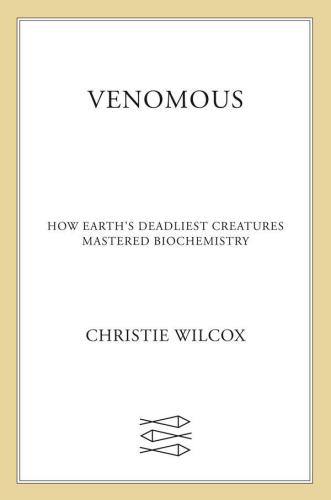
Venomous
How Earth's Deadliest Creatures Mastered Biochemistry
کتاب های مرتبط
- اطلاعات
- نقد و بررسی
- دیدگاه کاربران
نقد و بررسی

May 16, 2016
Wilcox, a molecular biologist, takes readers on a lively tour of animals that boast the ability to kill and maim others via their venom. Throughout the book, she uses an evolutionary framework to ask and answer questions about the origin and maintenance of venom across a wide swath of the animal kingdom. Wilcox impressively integrates personal anecdotes—once she was stung by a venomous sea urchin while teaching second graders about marine life—with summaries of the scientific literature, and brings to life the wonders of an intriguing but little-known portion of the biological world. She explores various venoms’ modes of action: disrupting nerve function, altering blood chemistry, and manipulating immune function. Wilcox discusses current research that has serious implications for human health; in one researcher’s estimation, animal venoms are a potential “pharmacological gold mine.” There is also reason to believe that it might be possible for scientists to craft a universal antivenom that will save significant numbers of lives annually. Whether she’s discussing snakes and pufferfish or Komodo dragons and spiders—not to mention octopuses, snails, platypuses, and bees—Wilcox relates technical biochemical and physiological information in a manner that is accessible and enjoyable. Agency: Susan Rabiner Literary.

June 15, 2016
How the creatures that embody some of mankind's deepest fears use toxic substances to defend themselves against predators and to prey on the creatures they eat--and why this is important to us today."There are two kinds of venom scientists," writes molecular biologist Wilcox: microbiologists interested in studying the molecular complexities of toxic compounds and their pharmaceutical potential and those who are attracted to the adventurous pursuit of the animals who secrete them. The author places herself in both camps. "I...got into the study of venoms because of my love for the animals," she writes. "But the more I learned about the intricate complexities of the chemical cocktails these animals produce, the more intrigued I was by the venoms themselves and the more I was drawn to the most dangerous of species." Our preoccupation with these creatures is deep-seated, as demonstrated by the limestone pillars of a 10,000-year-old Turkish temple that are decorated with a host of venomous creatures, including spiders, snakes, and scorpions. Furthermore, writes the author, "fear of many of them is innate in humans, found even in the youngest babes," and tens of thousands of people are killed each year despite the existence of anti-venoms--especially in poorer areas where access to treatment facilities is limited. Wilcox describes the debilitating pain she experienced after being stung by a poisonous sea urchin while shepherding schoolchildren on a field trip to study marine life. She admits that the frisson of danger is one of the appeals of studying these creatures in their natural environments. More significantly, she believes that there are "medical marvels...awaiting discovery in the deadliest of venoms," including possible treatments for diseases such as HIV and cancer. The author concludes with a compelling message on the need for venomous animals, which are part of the biochemical riches with which our planet has been endowed. Wilcox writes in a lively style, but the book is likely of greatest interest to those already drawn to the subject.
COPYRIGHT(2016) Kirkus Reviews, ALL RIGHTS RESERVED.

July 1, 2016
In this engaging mixture of science and anecdote, Wilcox (molecular biology, Univ. of Hawaii) explores venom--the peptide-protein substance animals use to defend themselves and subdue prey. It's an evil brew, but, paradoxically, as the burgeoning field of venom "bioprospecting" is discovering, what kills also cures. Readers learn how recent developments in research methods have opened up the pharmacopeia hidden in venom and get a look at therapeutics to come. Wilcox drills down to the molecular level to explain how two types of venom--hemotoxic and neurotoxic--function, how they have evolved, and what they teach us about the human body. The author relates how she was drawn to the topic by her love for animals, which is evident in her descriptions of some fantastic (if fearsome) creatures: the platypus, bullet ant, Komodo dragon, cone snail, box jellyfish, Gila monster, blue-ringed octopus--each of which can maim, destroy, and inflict unimaginable pain. All in all, this is a jolly read considering the occasionally gruesome subject matter. VERDICT Wilcox chronicles the history, present, and future of venom science in a fashion that nonspecialist readers will understand, without depriving her subject of its terrifying, utterly provocative aspects.--Robert Eagan, Windsor P.L., Ont.
Copyright 2016 Library Journal, LLC Used with permission.

Starred review from August 1, 2016
Venom. The word alone conjures up images of frightening beasties like rattlesnakes and scorpions, but as biologist Wilcox shows in her engrossing survey of the planet's venomous animals, these sometimes deadly creatures are found across the animal kingdom. There are venomous snails, frogs, jellyfish, insects, reptiles, spiders, and even mammals. To be considered venomous, an animal must be proactivethat is, it must deliver the venom into another animal. As Wilcox travels the world looking at these dangerously venomous creatures, she treats the reader to a simplified course in biochemistry and the fascinating physiology that goes into an animal's creation of venom. Starting with a visit to a male platypus, who angrily demonstrates his toxic spurs by stabbing a rolled-up towel, she then looks at snakes, bullet ants (possessors of the world's most painful sting), lionfish, sea urchins, a caterpillar that can make you bleed to death, Komodo dragons, and octopuses. Finally, in a nice turnabout to their deadly nature, Wilcox writes of the almost miraculous pharmaceuticals that are being developed from venoms. Superbly entertaining popular science.(Reprinted with permission of Booklist, copyright 2016, American Library Association.)

























دیدگاه کاربران